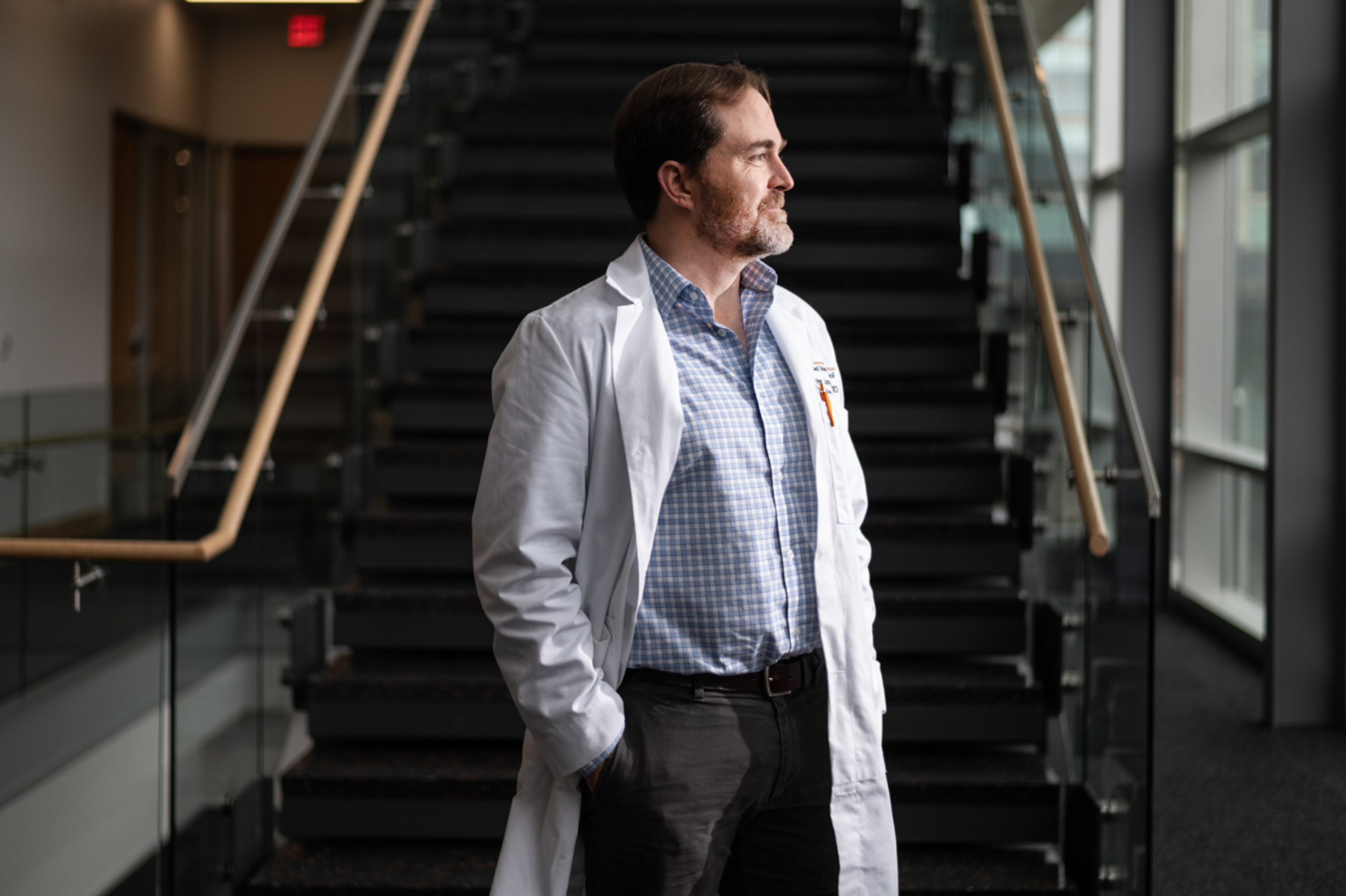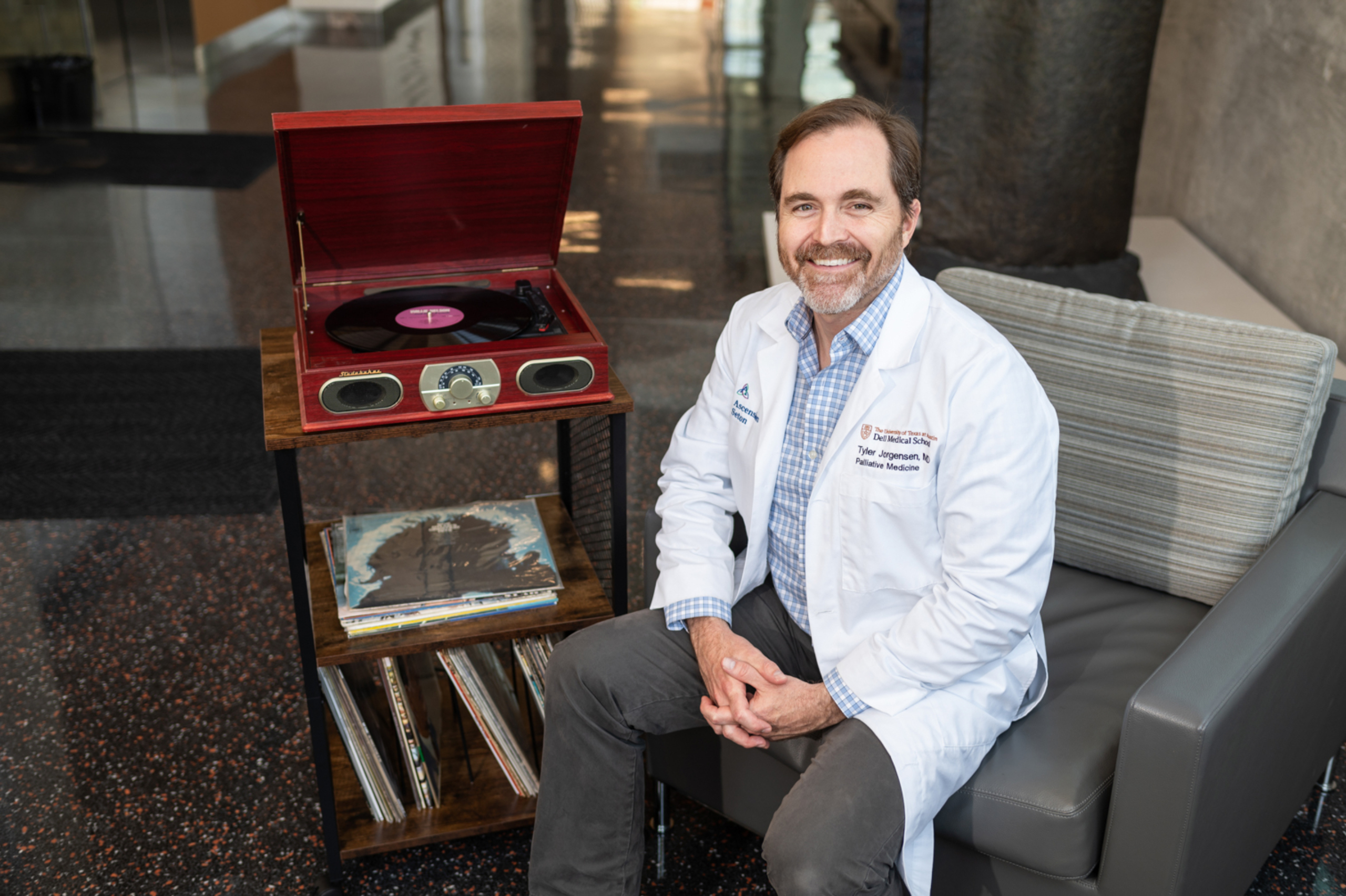Tyler Jorgensen, M.D., practiced emergency medicine for more than a decade before pursuing a fellowship in hospice and palliative medicine. Now, he’s on a mission to provide a human element to end-of-life care, armed with some unexpected tools: a cart, a record player and a library of vinyl records.
Through the Distinction in Care Transformation track of Dell Med’s Advancing Care Transformation curriculum, Jorgensen and his team developed ATX-VINyL: a resource that encourages patients and their families to connect through music, adding comfort and nostalgia to their patient rooms during the last stages of their care.

Tyler Jorgensen, M.D.
What’s the problem you’re hoping to solve, and how did you come to recognize it?
Hospitalizations, particularly in the ICU, are times of great distress, anxiety, fear and pain for many patients and their loved ones. A patient’s autonomy, the integrity of their personhood and even their very lives are threatened by the illness they now face. Patients in a sterile hospital setting can often feel disconnected from their humanity.
Alternative therapies like music interventions not only help alleviate symptoms such as pain and anxiety, but they also promote well-being and help patients and caregivers reconnect to their sense of self. We physicians often fail to recognize the value that non-pharmacologic therapies can bring.
What are you doing during your medical education to prepare to solve this problem?
The “Audio Therapy eXperience-Vinyl for Inpatients Near the end of Life,” or ATX-VINyL, is a novel approach we developed this year at Dell Seton Medical Center at The University of Texas. With ATX-VINyL, we wheel a record player on a cart containing a wide-ranging library of vinyl records into patient rooms. This provides patients and their loved ones an opportunity to experience therapeutic music of their choosing together and at their own pace.

Jorgensen alongside an ATX-VINyL record library.
Many forms of recorded music have been shown to lower pain scores, decrease anxiety and depression, and promote loved ones’ well-being. However, we feel that vinyl records in particular — in contrast to more readily available electronic modalities of music — provide a more unique and multisensory experience.
Records provide tactile, visual and auditory stimulation, while often evoking nostalgia and drawing on positive shared memories. We specifically chose a wide-ranging library of records to represent music from across diverse cultural backgrounds, allowing for a customizable, patient- and family-centered experience. We have found that the record player and records are like a time machine for our patients, transforming them back to a happier time in their lives.
We are still studying the impact, but a recent survey of residents, nurses and advanced practice providers reveals uniformly positive experiences with the record player. Anecdotally, our patients and families (and our staff) have reported a significant boost in their well-being after using ATX-VINyL. A recent patient and his family stated that using ATX-VINyL was the first time they had felt fully human again after many weeks in the hospital.
What kind of change do you hope to see, in Austin and beyond?
As physicians, we need to deliver our care in a way that respects and honors the humanity and dignity of each patient we care for. This includes tailoring our therapeutic strategies toward patient-centered goals of care. But caring for our patients’ personhood can also include the incorporation of some “human” elements as we treat their illnesses and injuries — music, art, poetry, stories, laughter. Educational efforts highlighting research that supports the use of these therapies can help providers and institutions understand the value of non-pharmacologic interventions.
Ideally, hospitals in Austin, across Texas, and around the world will grow to value complementary therapies and devote resources toward music and art therapy experts and toward artistic resources that can be shared with patients.
I find it very interesting that children’s hospitals seem to understand the need for these sorts of things intuitively — they are filled with art, music, and interactive play and therapies — but our adult hospitals often are not. Patients still need these things even after they turn 18-years-old.
What makes you positioned to approach this problem? Is there a personal experience, a critical collaboration or a unique approach in play?
I have dedicated significant time this year to studying existing research on music interventions for terminally and critically ill patients. I have also met with researchers from around the country and internationally to discuss and workshop our latest music intervention strategies.
I practiced emergency medicine for over a decade before pursuing training in palliative medicine and I had a front row seat to the distress, fear, pain and anxiety that acute medical illnesses and traumatic injuries can cause. Now in palliative medicine, I have truly enjoyed being able to focus more on the human experiencing the illness than the illness itself. I stress to our residents and medical students that one of our main jobs is to learn to connect with the human inside each patient. Then we will know how to best care for them.
This news feature is part of Dell Med’s Voices, a series of profiles that highlight the people of Dell Med as they work to improve health with a unique focus on our community.